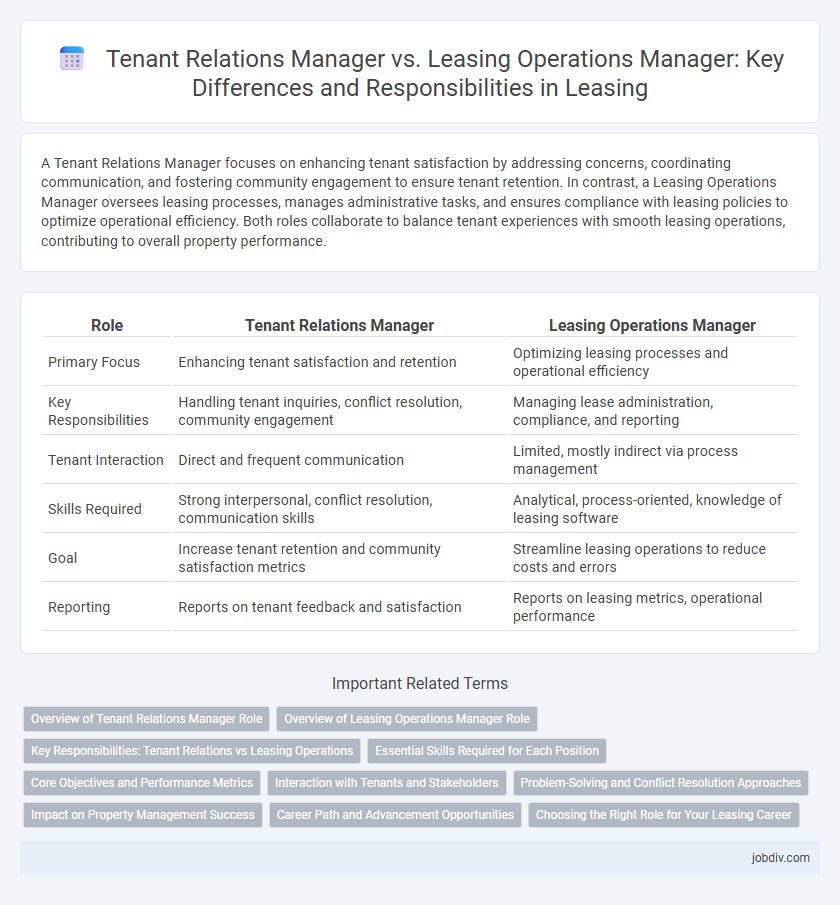A Tenant Relations Manager focuses on enhancing tenant satisfaction by addressing concerns, coordinating communication, and fostering community engagement to ensure tenant retention. In contrast, a Leasing Operations Manager oversees leasing processes, manages administrative tasks, and ensures compliance with leasing policies to optimize operational efficiency. Both roles collaborate to balance tenant experiences with smooth leasing operations, contributing to overall property performance.
Table of Comparison
| Role | Tenant Relations Manager | Leasing Operations Manager |
|---|---|---|
| Primary Focus | Enhancing tenant satisfaction and retention | Optimizing leasing processes and operational efficiency |
| Key Responsibilities | Handling tenant inquiries, conflict resolution, community engagement | Managing lease administration, compliance, and reporting |
| Tenant Interaction | Direct and frequent communication | Limited, mostly indirect via process management |
| Skills Required | Strong interpersonal, conflict resolution, communication skills | Analytical, process-oriented, knowledge of leasing software |
| Goal | Increase tenant retention and community satisfaction metrics | Streamline leasing operations to reduce costs and errors |
| Reporting | Reports on tenant feedback and satisfaction | Reports on leasing metrics, operational performance |
Overview of Tenant Relations Manager Role
A Tenant Relations Manager focuses on enhancing tenant satisfaction, addressing concerns, and fostering a positive community atmosphere within leasing properties. This role involves direct communication with tenants to resolve issues, coordinate maintenance requests, and improve tenant retention rates. Their primary goal is to maintain strong tenant relationships that support the overall success of property management operations.
Overview of Leasing Operations Manager Role
A Leasing Operations Manager oversees the entire leasing process, ensuring smooth coordination between marketing, tenant screening, lease administration, and move-in procedures to maximize occupancy rates. This role requires managing leasing teams, streamlining operational workflows, and implementing compliance with leasing policies and local regulations. Expertise in property management software, financial reporting, and customer service is essential to optimize leasing performance and tenant satisfaction.
Key Responsibilities: Tenant Relations vs Leasing Operations
Tenant Relations Managers focus on fostering positive tenant experiences through addressing tenant concerns, coordinating community events, and ensuring lease compliance to maintain high tenant satisfaction and retention. Leasing Operations Managers oversee the lease administration process, including lease documentation, rent collection, and coordination between leasing agents and property management to streamline operational efficiency. The Tenant Relations role emphasizes direct tenant engagement and service, while Leasing Operations centers on administrative oversight and process management in leasing activities.
Essential Skills Required for Each Position
Tenant Relations Managers require exceptional interpersonal communication, conflict resolution, and customer service skills to effectively address tenant concerns and maintain positive community engagement. Leasing Operations Managers must possess strong organizational abilities, proficiency in lease administration software, and analytical skills to oversee leasing processes, compliance, and operational efficiency. Both roles demand a solid understanding of real estate regulations and lease agreements to ensure smooth property management and tenant satisfaction.
Core Objectives and Performance Metrics
A Tenant Relations Manager focuses on enhancing tenant satisfaction and retention through effective communication and timely issue resolution, with key performance metrics including tenant satisfaction scores, renewal rates, and response times to tenant inquiries. In contrast, a Leasing Operations Manager concentrates on streamlining leasing processes, optimizing occupancy rates, and ensuring compliance with leasing policies, measured by metrics such as lease execution speed, occupancy percentages, and operational cost efficiency. Both roles aim to maximize property value but differ in their core objectives, with one prioritizing tenant experience and the other operational excellence.
Interaction with Tenants and Stakeholders
Tenant Relations Managers specialize in direct, day-to-day communication with tenants, addressing concerns, resolving conflicts, and enhancing tenant satisfaction to foster long-term occupancy. Leasing Operations Managers oversee broader stakeholder interactions, including coordinating with property owners, maintenance teams, and legal departments to streamline leasing processes and ensure operational efficiency. Both roles require strong interpersonal skills, but Tenant Relations Managers prioritize tenant engagement while Leasing Operations Managers focus on integration across multiple operational functions.
Problem-Solving and Conflict Resolution Approaches
Tenant Relations Managers specialize in resolving tenant disputes by employing empathetic communication and personalized conflict mediation to maintain tenant satisfaction and retention. Leasing Operations Managers focus on systemic problem-solving through process optimization and enforcing compliance to reduce lease violations and operational inefficiencies. Both roles utilize strategic negotiation skills, but Tenant Relations Managers prioritize interpersonal solutions, while Leasing Operations Managers emphasize procedural adjustments.
Impact on Property Management Success
Tenant Relations Managers directly enhance tenant satisfaction and retention through effective communication and conflict resolution, creating a positive community atmosphere that reduces vacancy rates. Leasing Operations Managers optimize leasing processes, ensuring efficient tenant onboarding, lease administration, and compliance, which streamlines property management workflows and improves overall operational efficiency. Combined, these roles synergize to maximize revenue, maintain property value, and elevate the success of property management by balancing tenant experience with operational excellence.
Career Path and Advancement Opportunities
Tenant Relations Managers typically advance by developing strong interpersonal skills and expertise in tenant retention, often progressing to senior property management roles or regional management positions. Leasing Operations Managers focus on optimizing leasing processes and data-driven decision-making, which can lead to careers in portfolio management, operations director roles, or executive leadership within real estate companies. Both paths offer advancement through specialized knowledge--Tenant Relations in client engagement and Leasing Operations in operational efficiency--supporting diverse career trajectories in property management.
Choosing the Right Role for Your Leasing Career
Tenant Relations Manager focuses on fostering strong communication and satisfaction between tenants and property management, requiring excellent interpersonal and conflict resolution skills. Leasing Operations Manager oversees the operational aspects of leasing, such as compliance, process optimization, and team management, demanding strong organizational and leadership abilities. Choosing the right role depends on whether you prefer direct tenant engagement or managing the broader leasing operations and strategy.
Tenant Relations Manager vs Leasing Operations Manager Infographic

 jobdiv.com
jobdiv.com